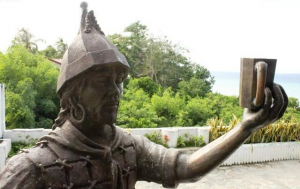Proem
The span of time from the Cry of Pugad Lawin to the Pact of Biac-na-Bato, was the first phase of the Philippines Revolution against Spain. The group of General Aguinaldo agreed to stop fighting with a promise of reforms and a payment of P800 thousand with P400 thousand as advance payment. General Aguinaldo and his officials agreed to be on self-exile in Hong Kong.
General Aguinaldo agreed to the arrangement because there was no longer any money to finance the revolution. Part of the down payment was used to purchase rifles and ammunitions from Japan. Unfortunately the ship that carried the bought weapons sank and the renewal of the revolution was stymied.
Even with the self-exile of the leaders of the revolution, the revolution in the Philippines continued through the further organization of the Katipunan.
The Second Phase
On March 11, 1898 the Katipunan Organization reached Cebu. It made its own organization with Don Luis Flores as President with Leon Kilat as General-in-Chief. It openly fought the Spaniards on April 3, 1898.
The uprising in Cebu was defeated by the Spaniards and many Cebuano fighters fled to Bohol and became bandits. Tagbilaran, Bohol organized its own self-defense force under the leadership of Don Salustiano Borja to fight against the Cebuano bandits.
On May 1, 1898 the American fleet under Commodore George Dewey defeated the Spanish fleet under Admiral Patricio Montojo in the Battle of Manila Bay.
Thereafter the Americans fetched Gen. Aguinaldo and his men from Hong Kong and brought them to the Philippines. They arrived on May 19, 1898. They were given weapons by the Americans and told to fight the Spaniards. It was the start of the second phase of the revolution.
On June 12, 1898 Gen. Emilio Aguinaldo ordered the proclamation of independence at his residence in Kawit, Cavite. From then on so many places in the Philippines, including Bohol, recognized Gen. Emilio Aguinaldo as the leader of the Philippines Revolution.
Organization in Bohol
Even with the revolution going on, the Americans and the Spaniards made a deal that the Americans will purchase the Philippines and Puerto Rico from the Spaniards for the price of $20 Million. Even with the Philippine’s protest the American Congress approved the deal.
The Spaniards were then told to withdraw from all places in the Philippines by December 20, 1898.
On this date Cebu Lt. Gen. Emilio Verdeflor was sent by Cebu President Don Luis Flores to Tagbilaran to organize the Provincial Government of Bohol.
The following were elected: 1.) Salustiano Borja – Presidente. 2.) Margarito Torralba – Delegado del Justicia. 3.) Macario Sarmiento – Delegado de Policia. 4.) Mariano Parras – Delegado de Rentas.
These officials received the turnover of responsibilities from the Spanish government to the local government on December 25, 1898. Doing the turnover ceremony was Don Eduardo Calceta, the Gobernadorcillo (now: Mayor) of Tagbilaran.
The elected officials acted as the Provincial Government in Bohol. At least it was able to give a semblance of order when the Spaniards and their followers left on December 20, 1998. The money and properties left behind were properly safeguarded and accounted for.
In early January 1899, two commissioners from Manila came to Tagbilaran to ask for contributions to the national treasury. The Boholanos did not give because the commissioners brought credentials from Secretary of Finance Mariano Trias and not from President Aguinaldo.
Second Gobierno de Canton
Don Eduardo Calceta and Don Bernabe Reyes were from Cavite. They sent a letter to President Aguinaldo that the Government in Bohol existed by authority of Cebu and not by the National Government.
President Aguinaldo sent down a letter of authorization to elect a new set of officials. Elected were: 1.) Bernabe Reyes – Governador. 2.) Salustiano Borja – Vice Gobernador. 3.) Rafael Reyes – Consejero de Hacienda Publica. 4.) Eduardo Calceta – Consejero de Justicia. 5.) Macario Sarmiento – Consejero de Policia. 6.) Braulio Flores – General de Division de todo la Provincia (Later on replaced by Pedro Samson, from Cavite.)
Don Bernabe Reyes, Rafael Reyes, Eduardo Calceta, and Pedro Samson were not native Boholanos.
They Invested the Money
When the commissioners who came to Bohol went to Cebu, they discovered that the Boholano Government invested the huge amount of one-hundred fifty thousand (P150,000) in a foreign commercial establishment using their own names.
The book “Under Four Flags” by J.W. Arrowsmith Ltd., Bristol, England, 1972, p. 28, says that the Shipping Department of Smith, Bill, & Co., managed the inter-island steamers “Bohol”, “Rosa”, “Jaime Vaño”, and the “Cebu”.
It is known that the ships “Bohol” and “Jaime Vaño” were owned by Bernabe Reyes either wholly or partly.
The actions of the Bohol Provincial Government can be justified because President Aguinaldo authorized the Smith, Bell, & Co. to operate and that the decree of Pres. Aguinaldo said in Rule 31. “…take charge of all the property belonging to the towns as well as those left by the Spaniards, and the same shall be administered in the best way as the council thinks fit.”
During and After the War
We do not have a clear record what happened to the money invested by the Boholano Officials in Cebu. However on Nov. 12, 1992 I had an interview with Mr. Arsenio Bullen (b. Dec. 14, 1908) at his residence in Dauis, Bohol. He lived just across the street to the residence of Gov. Bernabe Reyes in Dauis.
He said that he knew that Gov. Reyes was suspected by the Boholano revolutionaries to have privately claimed the invested money in Cebu. It was the reason why Gov. Reyes sought protection from the Americans and did not anymore sided with the Boholano fighters. His attitude was different from Gen. Pedro Samson who took over the leadership and became respected after the war.


Be First to Comment